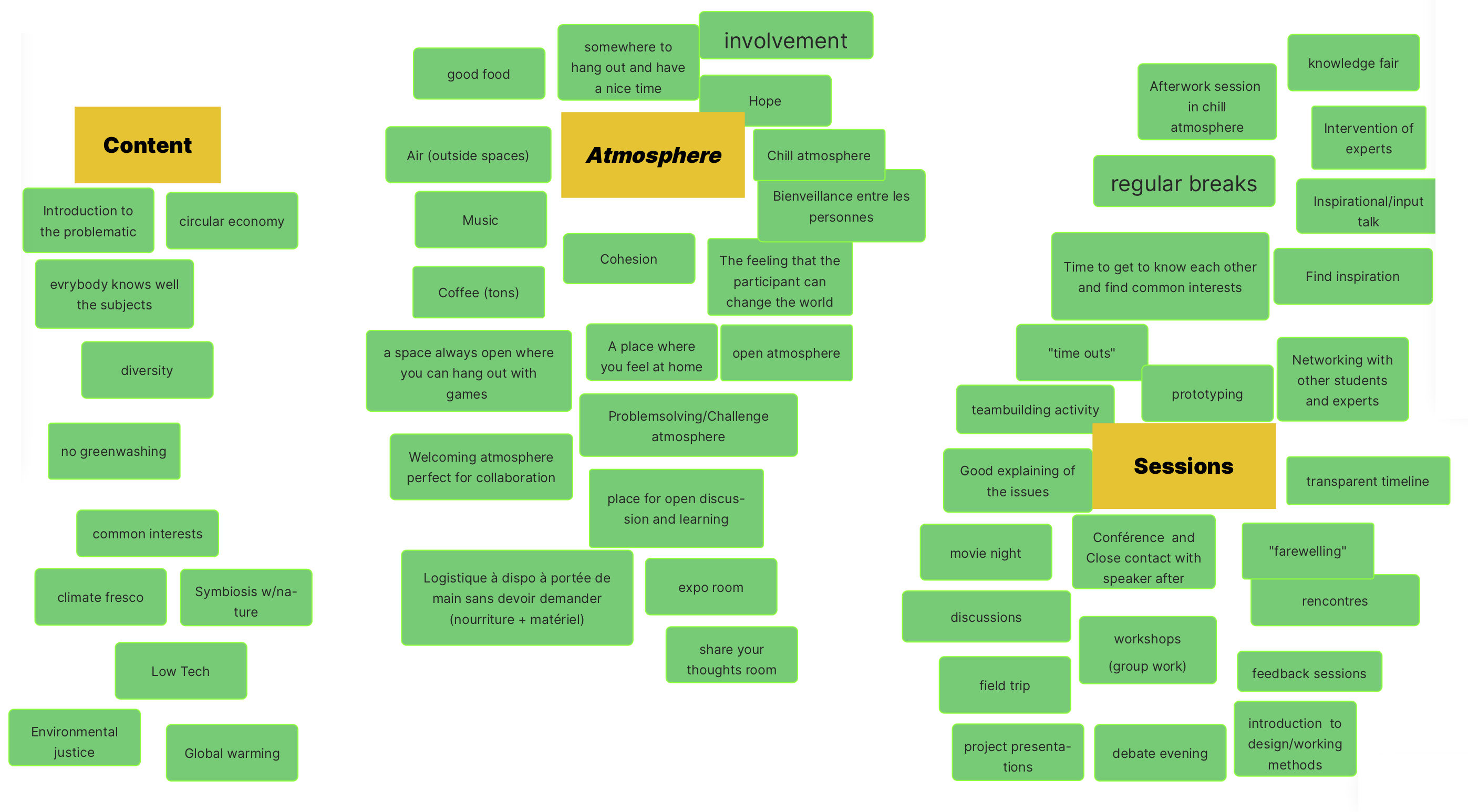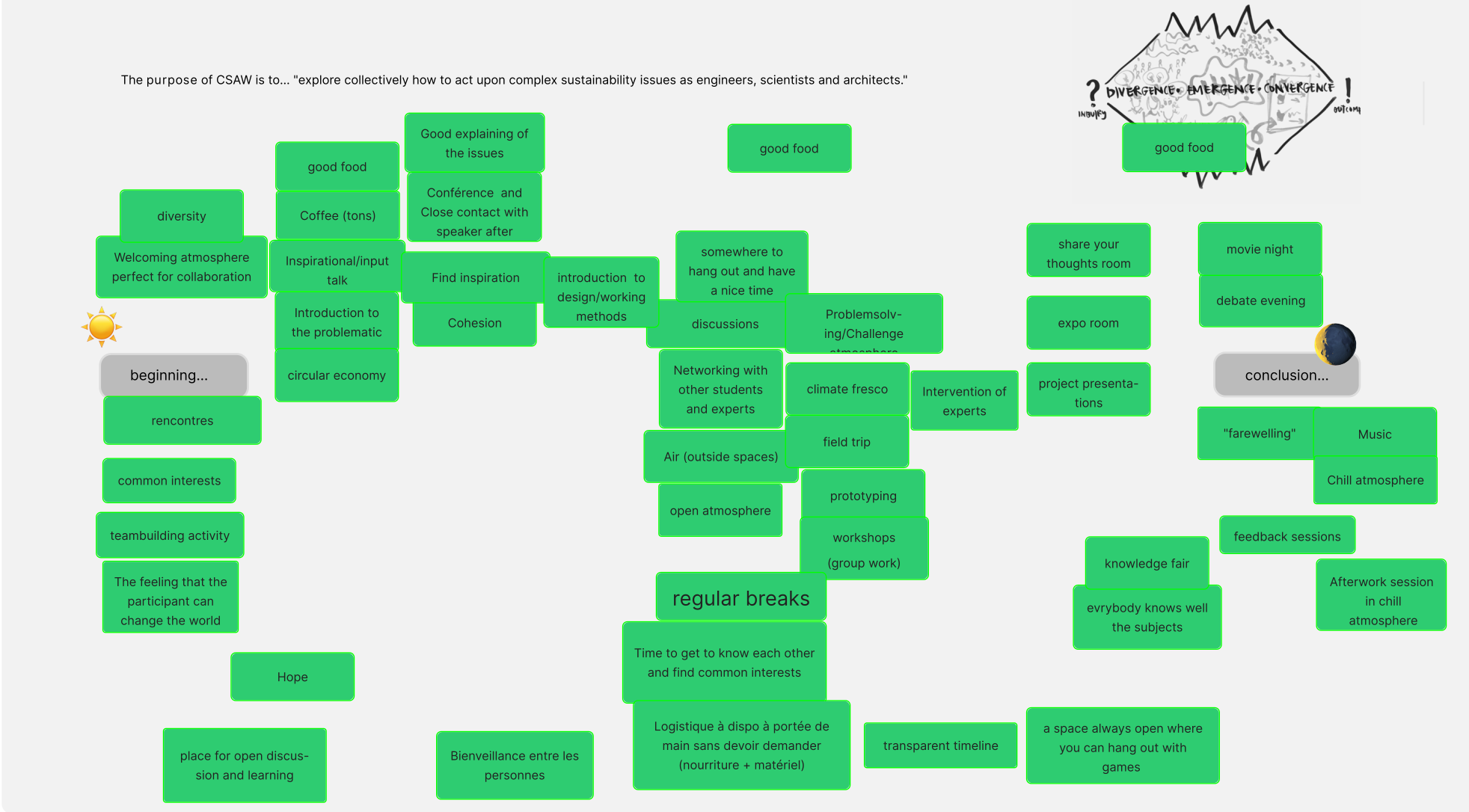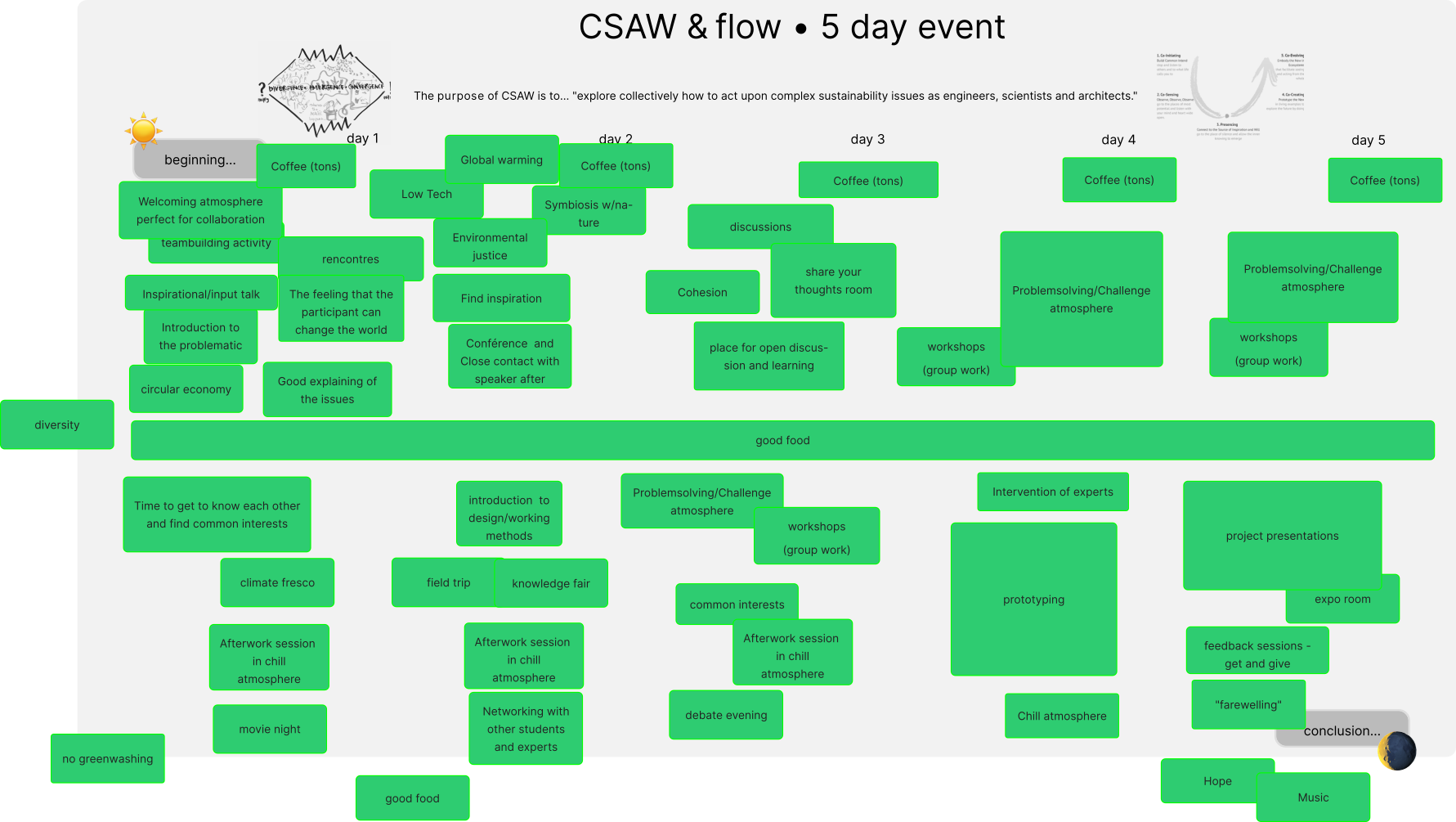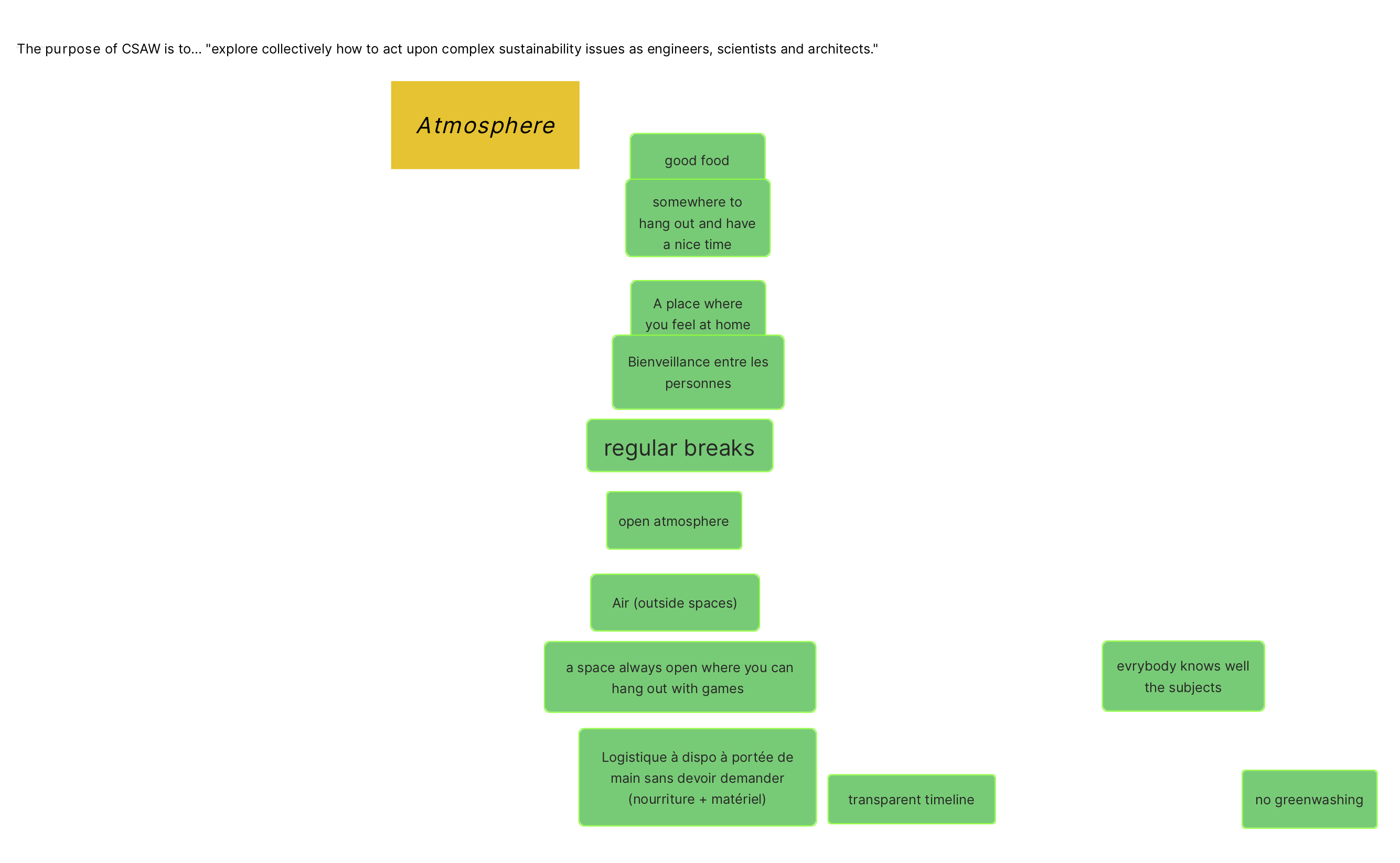Flow Exercise
The flow provides an overview of the event as a whole, as well as the connections between different elements (such as contents, formats, materials, spaces and the participants). The connections between the elements happen in space and in time, so the flow has spatial and temporal aspects.
Spatial flow
… brings together the physical and sensory aspects of the event (e.g. atmosphere, indoor & outdoor space design, movement between spaces)
When designing the atmosphere it's worth considering:
- what are your design principles?
- how is the theme and the purpose of the event manifested in the design?
- what are the characteristics of the site / venue? how can you make your event site specific?
- what are your design elements? (e.g. furniture, lighting, indoor and outdoor spaces, objects, graphic design…) and how are they connected to produce an engaging atmosphere?
- how to engage multiple senses?
- how to facilitate physical presence and movement of groups and individuals through the space?
- how to be inclusive, providing an experience for people with different physical and mental abilities?

Temporal flow
Temporal flow (aka event flow) is the progression of different components of an event, which is visible to the participants as the programme.
When designing the event flow, consider the participants, the content and the process:
Participants
(mostly human beings, though there might be some non human participants too)
- who are the participants?
- how does the event develop during the day, with changing energy levels and mental capacity? (eg. morning focus, after lunch dip, engaged afternoon, social/inspirational evenings)
- how does focus change during the event? (divergence, emergence, convergence)
- what can people process better individually and what should be worked on in a group (→ if group work, plenary or breakout groups)?
- how do you want the participants to feel at the conclusion of the event?
- do you want the relationship with the participants to continue after the event? what do you have to do to make this happen?
Content
- what topics or questions should be addressed?
- how do the topics relate to each other? (e.g. broad theme, sub questions, connected topics…)
- what and how can the participants contribute to the content of the event? (open space / unconference)
- what do you know about the content? what do you not know? what do you need to learn?
- who knows about the content? who would be appropriate to introduce the content at the event?
- how will you 'harvest', collect or record the content and the results of the event? (graphic recording, AV, social media…)
Process
- what are the different ways that participants can engage with the content of the event?
- what formats and methods could be appropriate for specific topics?
- do you have sufficient diversity of methods to engage different modes of learning (verbal, visual, embodied, theoretical, practical…)
- what formats work better at different times of day? (e.g. lectures in the morning, hands on workshops in the afternoon, immersive experiences or social gatherings in the evening…)
- how do different sessions relate to each other and the timeline of the event?
- what are the 'inputs' and the 'outputs' of each session?
- how are the intermediate results connected to reach the desired outcome?
- how does it end?
- hat will the follow-up look like?
A useful pattern to keep in mind is that co-creative flows often happen in three phases divergent, emergent and convergent:
- Divergence: broadening the perspective to the wider world, understanding a shared context. - what is circular economy, what are some interesting existing case studies, what is emerging
- Emergence: grounding the group's knowledge in their own lived experience, understanding their position in the context of the event and seeding new ideas of how things could be otherwise. - what are the participants themselves doing in this field, how do they feel about it, what are they passionate about, where is their energy?
- Convergence: manifesting the ideas through co-creation, making them concrete in some way, and deciding how to move forward.

CSAW Flow exercise
The Purpose
Before starting to design the flow it's important that you agree on the purpose of CSAW. The reason for which you're doing the event – the purpose – should be as clear as possible, because all aspects of the design should be in service of fulfilling this purpose.
Q: What is the purpose of CSAW? What do you want to achieve at the end of the event?
A: “The purpose of CSAW is to explore collectively how to act upon complex sustainability issues as engineers, scientists and architects.”
The Ingredients
What are the key ingredients of CSAW? E.g. contents, formats, modalities, atmospheres, sensations… Group the ingredients in related clusters. Check if the ingredients are aligned with the purpose of the event.
Temporal Flow
Combine the different ingredients into a flow for the event. First try a quick-and-dirty flow for CSAW as a one day long event, then we'll try extending the flow to five days, the duration of the pilot.
CSAW: In One Day
Imagine that you were designing a prototype CSAW event that would last one day. What of the ingredients would be key to include? Where in the day would they happen? You don't have to use all the ingredients, only the most essential ones. Ingredients for the overall atmosphere of the event you can place along the bottom. Atmosphere specific to a session put next to the session.
What is missing? Do we need additional or transitional ingredients? Are there too many ingredients? Look back at the purpose of the event: does each of the components, the sequence of components and the flow as a whole lead towards the fulfillment of the purpose?
What is the spatial flow of the event - where does each component happen and how do the people move from one thing to the next?
CSAW Five Day Pilot
How would you extend a one day event into a five day event? What would happen in the mornings, afternoons, evenings? How would the week develop, what would happen on different days? What are the inputs and the outputs of the individual sessions? How do the sessions flow from one to another towards the desired outcome?
[Q] There are some possible points of tension during the week. In the 'emergent' phase, so towards the middle of the week when people start working on things together - interesting ideas, engaged discussions and great questions are emerging but it may not be clear to some participants how to get to a desired result. Also, at the point of convergence on the last day, when the pressure of realisation or production becomes high, the benefits of 'exploring things together' might become lost in the rush to complete something. Also, the presentations themselves should be carefully designed - avoid long sequential presentations, try something playful, exploratory - the presentation format itself works better when aligned with the exploratory purpose of CSAW - e.g. an open lab, bazaar/fair, open mic, etc.



